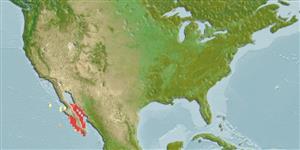Teleostei (teleosts) >
Ophidiiformes (Cusk eels) >
Ophidiidae (Cusk-eels) > Ophidiinae
Etymology: Lepophidium: Latin, lepus, leporis = rabbit + Greek, ophis = serpent (Ref. 45335).
More on author: Gilbert.
Environment: milieu / climate zone / depth range / distribution range
Ecology
Marine; demersal; depth range 20 - 238 m (Ref. 36413). Subtropical; 29°N - 21°N, 119°W - 110°W (Ref. 91765)
Eastern Pacific: from the Gulf of California (Bahía de Los Angeles in the northern Gulf to Bahía de La Paz in the south) and from the outer coast of Baja California (Cedros Island) up to near the southern tip of the peninsula.
Size / Weight / Age
Maturity: Lm ? range ? - ? cm
Max length : 24.6 cm SL male/unsexed; (Ref. 91765)
Dorsal spines (total): 0; Dorsal soft rays (total): 123 - 131; Anal spines: 0; Anal soft rays: 103 - 109; Vertebrae: 80 - 84. This species is characterized by the following: usual number of vertebrae, precaudal 14 (rarely 13), caudal 53-54 (55), total 81-82 (80-84); number of fin rays, dorsal 123-131, anal 103-109, pectoral usually 20-21 (19-24); pyloric caeca usually 6 (5-7) in 2 whorls, usually 5-6+1; first gill arch with rudimentary rakers 4 (3-6) on the upper arm, 8 (7-10) developed rakers on the lower limb, 5-9 rudimentary rakers anteriorly on the first arch; total rakers 16-19; dorsal-fin origin often between neural spines 4-5 (11 specimens) and rarely between 2-3 or 3-4 (1 specimen) (Ref. 91765).
Rare species (Ref. 34024) inhabiting soft bottom (Ref. 9329). Oviparous, with planktonic larvae (Ref. 36413). Oval, pelagic eggs float in a gelatinous mass (Ref. 205). Little is known of this species (Ref. 9329).
Life cycle and mating behavior
Maturity | Reproduction | Spawning | Eggs | Fecundity | Larvae
Robins, C.R., R.H. Robins and M.E. Brown, 2012. A revision of Lepophidium (Teleoastei, Ophidiidae), with descriptions of eight new species. Bulletin of the Florida Museum of Natural History 52(1):1-94. (Ref. 91765)
IUCN Red List Status (Ref. 130435: Version 2024-1)
Threat to humans
Harmless
Human uses
Fisheries: of no interest
Tools
Special reports
Download XML
Internet sources
Estimates based on models
Phylogenetic diversity index (Ref.
82804): PD
50 = 0.5000 [Uniqueness, from 0.5 = low to 2.0 = high].
Bayesian length-weight: a=0.00102 (0.00046 - 0.00225), b=3.06 (2.88 - 3.24), in cm total length, based on all LWR estimates for this body shape (Ref.
93245).
Trophic level (Ref.
69278): 3.6 ±0.7 se; based on size and trophs of closest relatives
Resilience (Ref.
120179): High, minimum population doubling time less than 15 months (Preliminary K or Fecundity.).
Fishing Vulnerability (Ref.
59153): Low vulnerability (20 of 100).
